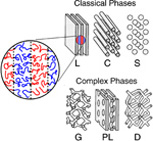Home > Press > Heterogeneous nanoblocks give polymers an edge: Study uncovers the effects of size variation in nanoscale blocks used in polymer mixes
 |
Abstract:
Building structures by mixing lego bricks of two different sizes is child's play. However, studying polymers endowed with an alternating nanostructure made of heterogeneous blocks is anything but straightforward. Theoretical physicist Mark Matsen, based at the University of Reading, UK, studies polymer mixes consisting of two-fold (AB) and three-fold (BAB) combinations of two types of nanoscale blocks. He has shown, in a study published in EPJ E, that the underlying heterogeneity of the blocks can cause polymers to switch to different nanoscale patterns and therefore display different properties. Numerous applications based on etching patterns on substrates, such as electronics, computer chips, and membranes endowed with a specific function, can benefit from such research.
Heterogeneous nanoblocks give polymers an edge: Study uncovers the effects of size variation in nanoscale blocks used in polymer mixes
Heidelberg, Germany | Posted on August 5th, 2013The problem is that, for a long time, polymer experts thought that achieving such an ordered nanostructure required using nanoblocks of similar sizes. However, experimentalists have recently shown that is not necessarily the case. As it turns out, it is generally sufficient to synthesise block copolymers using less costly methods, which result in block components of heterogeneous sizes.
To understand the effect of heterogeneous blocks on such polymer melts, the author compares polymer architectures made of three blocks, namely BAB, and two blocks, namely AB. In this case, A blocks are of heterogeneous size and B blocks are of homogeneous size. He relies on a method called self-consistent field theory (SCFT), which involves approximating the effect of all the other polymers on any given polymer by an averaged effect.
Matsen found that the use of heterogeneous building blocks affects the morphological structure of polymers at the nanometric scale. He also realised that by using heterogeneous components, particularly with triblocks, it is possible to shift the width of sub-domains made of one type of polymer. This could, for example, help in improving the effectiveness of triblock-based refractive surfaces.
####
For more information, please click here
Contacts:
Sophia Grein
49-622-148-78414
Copyright © Springer
If you have a comment, please Contact us.Issuers of news releases, not 7th Wave, Inc. or Nanotechnology Now, are solely responsible for the accuracy of the content.
| Related Links |
| Related News Press |
News and information
![]() Simulating magnetization in a Heisenberg quantum spin chain April 5th, 2024
Simulating magnetization in a Heisenberg quantum spin chain April 5th, 2024
![]() NRL charters Navy’s quantum inertial navigation path to reduce drift April 5th, 2024
NRL charters Navy’s quantum inertial navigation path to reduce drift April 5th, 2024
![]() Discovery points path to flash-like memory for storing qubits: Rice find could hasten development of nonvolatile quantum memory April 5th, 2024
Discovery points path to flash-like memory for storing qubits: Rice find could hasten development of nonvolatile quantum memory April 5th, 2024
Chip Technology
![]() Discovery points path to flash-like memory for storing qubits: Rice find could hasten development of nonvolatile quantum memory April 5th, 2024
Discovery points path to flash-like memory for storing qubits: Rice find could hasten development of nonvolatile quantum memory April 5th, 2024
![]() Utilizing palladium for addressing contact issues of buried oxide thin film transistors April 5th, 2024
Utilizing palladium for addressing contact issues of buried oxide thin film transistors April 5th, 2024
![]() HKUST researchers develop new integration technique for efficient coupling of III-V and silicon February 16th, 2024
HKUST researchers develop new integration technique for efficient coupling of III-V and silicon February 16th, 2024
Discoveries
![]() Chemical reactions can scramble quantum information as well as black holes April 5th, 2024
Chemical reactions can scramble quantum information as well as black holes April 5th, 2024
![]() New micromaterial releases nanoparticles that selectively destroy cancer cells April 5th, 2024
New micromaterial releases nanoparticles that selectively destroy cancer cells April 5th, 2024
![]() Utilizing palladium for addressing contact issues of buried oxide thin film transistors April 5th, 2024
Utilizing palladium for addressing contact issues of buried oxide thin film transistors April 5th, 2024
Materials/Metamaterials/Magnetoresistance
![]() Nanoscale CL thermometry with lanthanide-doped heavy-metal oxide in TEM March 8th, 2024
Nanoscale CL thermometry with lanthanide-doped heavy-metal oxide in TEM March 8th, 2024
![]() Focused ion beam technology: A single tool for a wide range of applications January 12th, 2024
Focused ion beam technology: A single tool for a wide range of applications January 12th, 2024
Announcements
![]() NRL charters Navy’s quantum inertial navigation path to reduce drift April 5th, 2024
NRL charters Navy’s quantum inertial navigation path to reduce drift April 5th, 2024
![]() Discovery points path to flash-like memory for storing qubits: Rice find could hasten development of nonvolatile quantum memory April 5th, 2024
Discovery points path to flash-like memory for storing qubits: Rice find could hasten development of nonvolatile quantum memory April 5th, 2024
Interviews/Book Reviews/Essays/Reports/Podcasts/Journals/White papers/Posters
![]() Simulating magnetization in a Heisenberg quantum spin chain April 5th, 2024
Simulating magnetization in a Heisenberg quantum spin chain April 5th, 2024
![]() Discovery points path to flash-like memory for storing qubits: Rice find could hasten development of nonvolatile quantum memory April 5th, 2024
Discovery points path to flash-like memory for storing qubits: Rice find could hasten development of nonvolatile quantum memory April 5th, 2024
|
|
||
|
|
||
| The latest news from around the world, FREE | ||
|
|
||
|
|
||
| Premium Products | ||
|
|
||
|
Only the news you want to read!
Learn More |
||
|
|
||
|
Full-service, expert consulting
Learn More |
||
|
|
||








